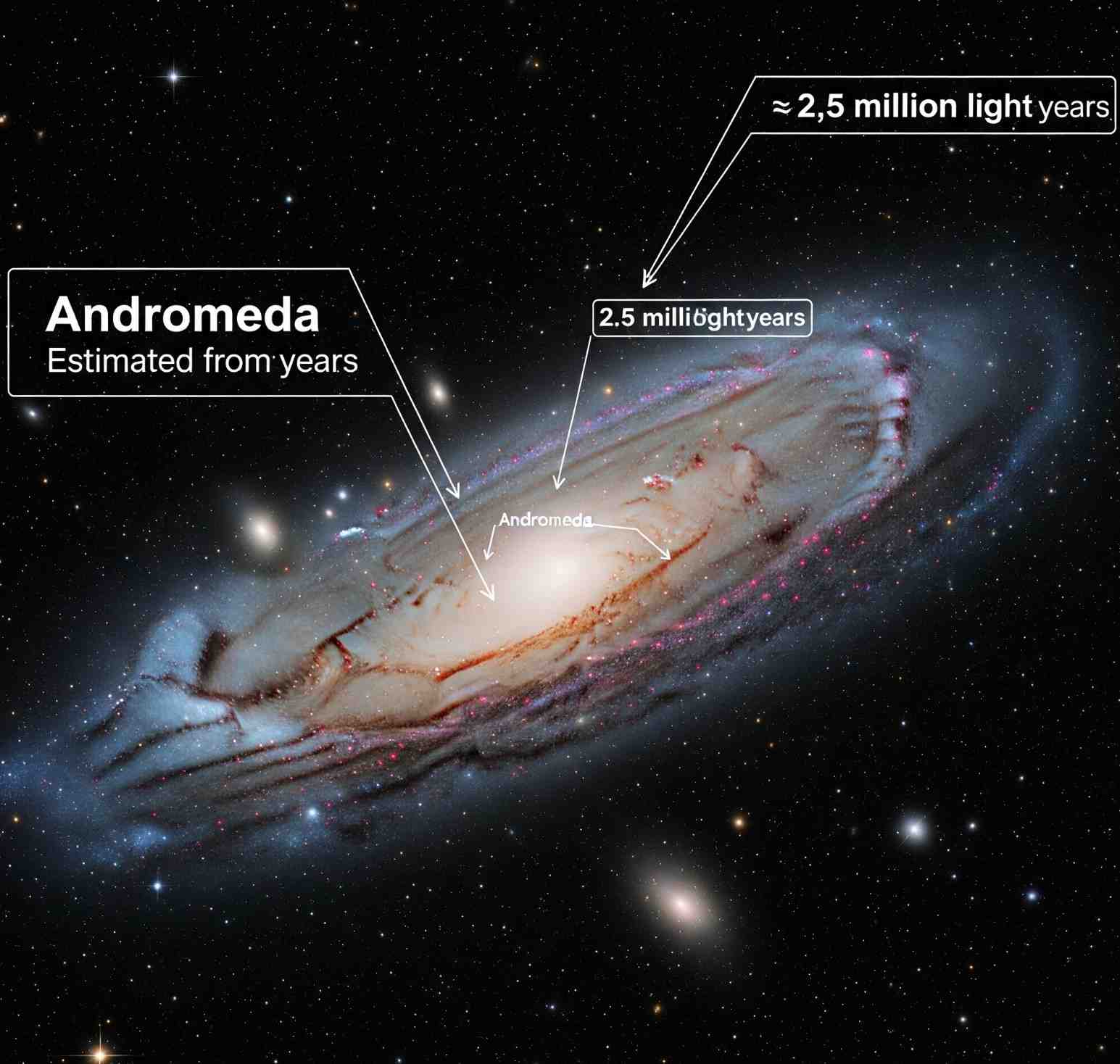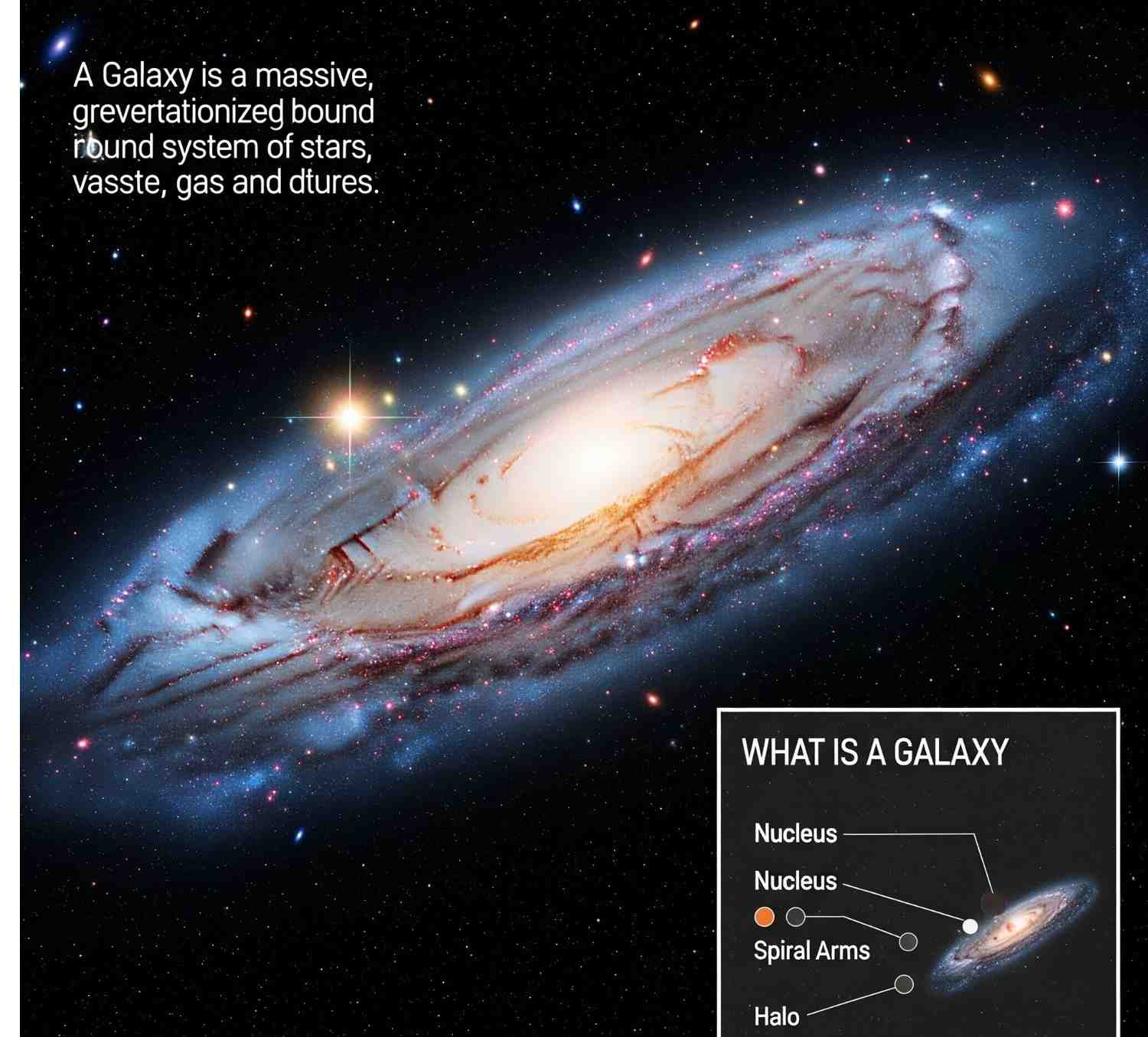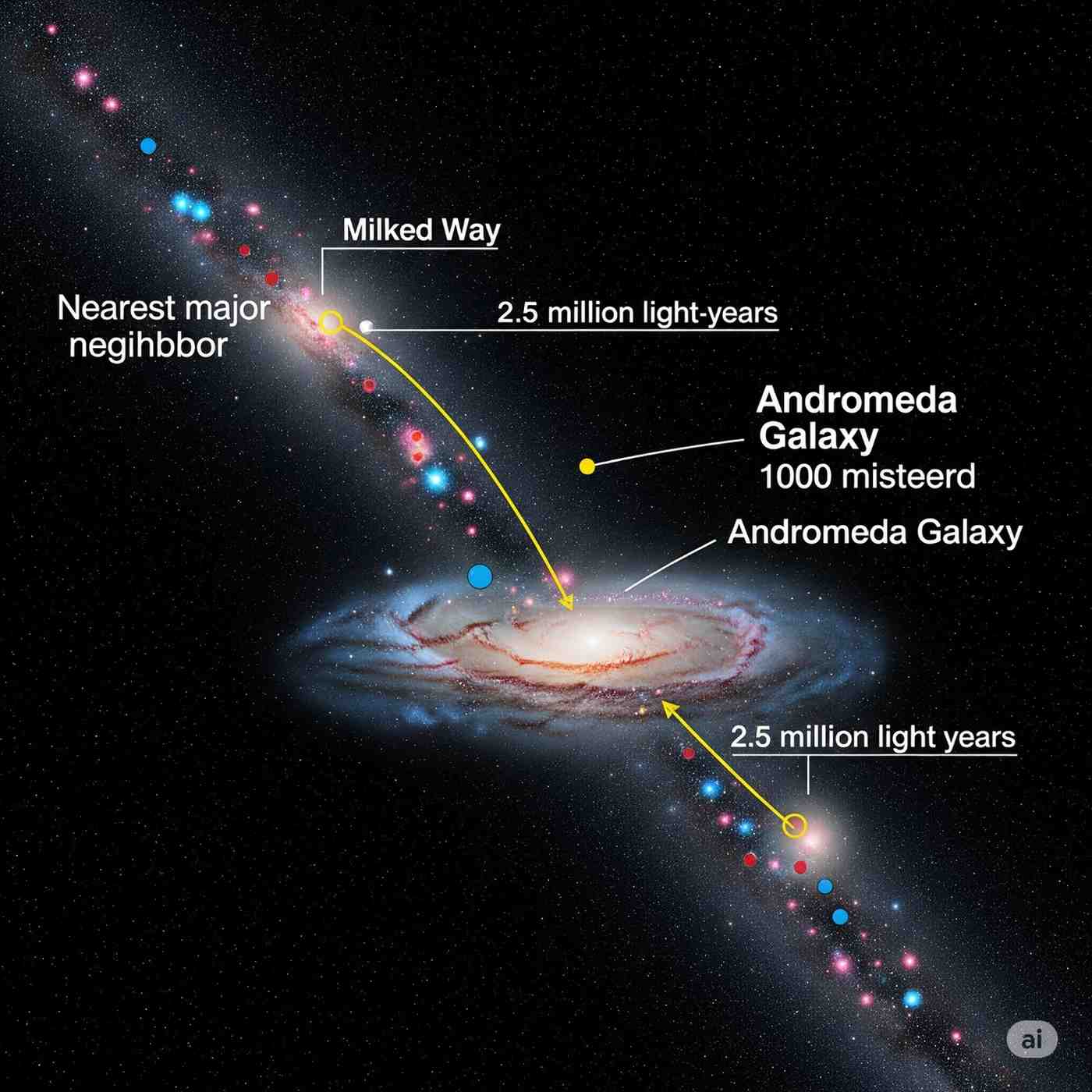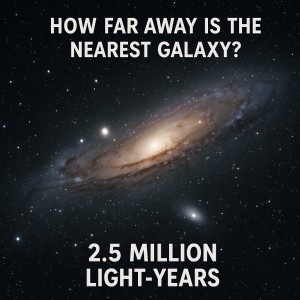How Far Away is the Nearest Galaxy?
Exploring Our Cosmic Neighborhood
When we gaze into the night sky, we often marvel at the stars, unaware that some of the faint, hazy patches of light are actually entire galaxies — colossal systems of stars, gas, dust, and dark matter. But have you ever wondered: how far away is the nearest galaxy to Earth? This seemingly simple question opens a doorway to one of the most fascinating realms of astronomy — our galactic neighborhood and the vast distances that define it.

Understanding Galaxies and Galactic Proximity
A galaxy is a massive gravitationally bound system that contains millions to trillions of stars, along with planetary systems, nebulae, black holes, and dark matter. Our own galaxy, the Milky Way, is home to our solar system, along with over 100 billion other stars.
When we ask about the “nearest galaxy,” the answer depends on whether we mean:
-
The nearest dwarf galaxy or satellite galaxy, or
-
The nearest major galaxy comparable in size to the Milky Way.
Let’s explore both.
Nearest Galaxies to the Milky Way
1. The Canis Major Dwarf Galaxy — Closest Known Galaxy
It was only discovered in 2003 and is hard to detect because it lies behind the thick disk of our galaxy.
2. The Sagittarius Dwarf Spheroidal Galaxy
3. The Large and Small Magellanic Clouds
These are two irregular dwarf galaxies visible from the Southern Hemisphere.
The Nearest Major Galaxy: Andromeda ]how far away is the nearest galaxy
When people refer to the “nearest galaxy,” they often mean the nearest major galaxy — one that’s similar in size and structure to the Milky Way. That honor belongs to the Andromeda Galaxy.
Fast Facts About Andromeda:
-
Distance from Earth: Approximately 2.537 million light-years
-
Diameter: About 220,000 light-years
-
Number of stars: Estimated at 1 trillion
-
Other name: M31
-
Visible with: The naked eye from dark skies in the Northern Hemisphere
Andromeda is not only the nearest spiral galaxy — it’s also on a collision course with the Milky Way. Astronomers predict that in about 4.5 billion years, the two galaxies will merge to form a new, massive elliptical galaxy, sometimes referred to as Milkomeda.
Why Do Distances Matter in Astronomy?
In space, distance is everything. Understanding how far galaxies are helps astronomers measure the size of the universe, estimate the speed at which it’s expanding, and determine the age of cosmic structures. The light-year, the distance light travels in one year (about 9.46 trillion kilometers), is the standard unit used to describe these immense gaps. how far away is the nearest galaxy
Measuring Galactic Distances
-
Cepheid Variable Stars — These pulsating stars have a predictable brightness, which helps gauge distance.
-
This shift in light helps calculate its distance. how far away is the nearest galaxy
Other Noteworthy Nearby Galaxies
Besides Andromeda and the Magellanic Clouds, here are a few other galaxies relatively close to us:
-
Triangulum Galaxy (M33) — Around 2.73 million light-years away and the third-largest in the Local Group.
-
Ursa Minor Dwarf — Roughly 205,000 light-years away.
These galaxies, along with the Milky Way and Andromeda, make up what astronomers call the Local Group — a collection of over 50 galaxies gravitationally bound together. how far away is the nearest galaxy
How Close is the Nearest Galaxy in Light-Years?
Unveiling the Cosmic Neighborhood Beyond the Milky Way ]how far away is the nearest galaxy
When we look up at the night sky, we often see stars — tiny specks of light scattered across the cosmos. But beyond those stars lie entire galaxies, massive cosmic cities composed of stars, planets, gas, dust, and dark matter. This simple question opens the gateway to understanding the size, scale, and structure of the universe beyond our own Milky Way galaxy. how far away is the nearest galaxy
What Is a Galaxy?
Our home, the Milky Way, is one such galaxy — a sprawling spiral galaxy that contains our solar system and over 100 billion other stars.
But the Milky Way is not alone. It is part of a galactic family known as the Local Group, which includes more than 50 galaxies of varying sizes. And within this family, some galaxies are extremely close — at least by cosmic standards.

Measuring Distance in Light-Years
Astronomers use light-years, a unit that represents the distance light travels in one year — about 5.88 trillion miles or 9.46 trillion kilometers.
Light from the Sun takes just 8 minutes to reach Earth. But light from galaxies can take thousands, millions, or even billions of years to reach us. how far away is the nearest galaxy
The Closest Galaxies to Earth
1. Canis Major Dwarf Galaxy
-
Distance: ~25,000 light-years
-
Type: Dwarf elliptical galaxy
-
Discovered: 2003
The Canis Major Dwarf Galaxy is currently considered the closest galaxy to Earth.
This galaxy was discovered relatively recently and is hard to observe directly because it lies behind the dense plane of the Milky Way. Its stars are being stretched and pulled apart by our galaxy’s gravity, and it’s in the process of merging with the Milky Way — part of the ongoing galactic evolution. how far away is the nearest galaxy
2. Sagittarius Dwarf Spheroidal Galaxy
-
Distance: ~70,000 light-years
-
Another satellite galaxy, the Sagittarius Dwarf is even now being cannibalized by the Milky Way. It’s an excellent example of how galaxies grow by absorbing smaller ones over time.
3. Large and Small Magellanic Clouds (LMC and SMC)
-
Distance:
-
Large Magellanic Cloud: ~160,000 light-years
-
Small Magellanic Cloud: ~200,000 light-years
-
Visible from the Southern Hemisphere, these irregular dwarf galaxies orbit the Milky Way and are among the brightest nearby galaxies in our sky. They are rich in gas and star-forming regions, providing valuable opportunities for astrophysical study. how far away is the nearest galaxy
Nearest Major Galaxy: Andromeda (M31)
While the galaxies mentioned above are relatively small, astronomers often refer to the Andromeda Galaxy as the nearest major galaxy to the Milky Way.
Andromeda Galaxy Facts:
-
Distance: ~2.537 million light-years
-
Type: Spiral galaxy (like the Milky Way)
-
Size: About 220,000 light-years in diameter
-
Stars: Estimated at 1 trillion
In approximately 4.5 billion years, the Milky Way and Andromeda are expected to collide and merge, forming a new galaxy — possibly named Milkomeda. how far away is the nearest galaxy
Although Andromeda is over 2.5 million light-years away, it’s close enough to be seen with the naked eye from Earth under dark skies, appearing as a faint blur. how far away is the nearest galaxy
Beyond Andromeda: More Nearby Galaxies ]how far away is the nearest galaxy
Triangulum Galaxy (M33)
-
Distance: ~2.73 million light-years
-
Type: Spiral
-
Relation: Believed to be gravitationally bound to Andromeda
Leo I Dwarf Galaxy
-
Distance: ~820,000 light-years
-
A satellite of the Milky Way, Leo I is very faint and difficult to observe.
How Do Astronomers Measure Galaxy Distances?
Measuring distances in the universe is not straightforward. Several sophisticated methods are used:
-
Parallax: Effective for stars within a few thousand light-years.
-
Cepheid Variable Stars: These pulsating stars have a known brightness, making them “standard candles” for measuring distances to nearby galaxies. how far away is the nearest galaxy
-
Type Ia Supernovae: Also standard candles, used for measuring very large distances.
-
Redshift: For faraway galaxies, the amount their light is stretched helps determine how far away they are, due to the expansion of the universe. how far away is the nearest galaxy
The Cosmic Perspective
The answer depends on how you define “galaxy”:
Either way, these galaxies are incredibly distant by human standards, yet close neighbors in the galactic sense. They serve as windows into the past and offer clues about how galaxies form, evolve, and interact. how far away is the nearest galaxy
Discovering Our Nearest Galactic Neighbor in the Vast Universe
When we look up at the night sky, we see the twinkling stars of our own galaxy — the Milky Way. Each one is a massive island in the universe, and there are billions of them. A question that fascinates scientists and stargazers alike is: What galaxy is the closest to Earth? At first glance, this might seem like a straightforward question, but the answer is layered with intriguing astronomical facts and discoveries.
Understanding What a Galaxy Is
Before we dive into which galaxy is closest to Earth, let’s clarify what a galaxy actually is. A galaxy is a huge system of stars, stellar remnants, interstellar gas, dust, and dark matter, all bound together by gravity. The Milky Way, our home galaxy, is just one of billions in the observable universe. how far away is the nearest galaxy
Galaxies come in many types:
-
Spiral galaxies (like the Milky Way and Andromeda)
-
Elliptical galaxies
-
Irregular galaxies
Some galaxies orbit larger ones as satellite galaxies, much like moons orbit planets.
So, What Galaxy Is the Closest to Earth? ]how far away is the nearest galaxy
The closest galaxy to Earth is not a large, well-known system like Andromeda. It’s actually a tiny, dim galaxy hiding within our cosmic neighborhood.
🔹 The Canis Major Dwarf Galaxy
-
Distance: ~25,000 light-years from Earth
-
Location: In the constellation Canis Major
-
Type: Dwarf irregular/elliptical galaxy
-
Discovery: Announced in 2003
The Canis Major Dwarf Galaxy holds the title of being the closest known galaxy to Earth. It’s a satellite galaxy of the Milky Way and was discovered relatively recently due to its faintness and the fact that it lies behind the thick disk of the Milky Way. This galaxy is currently being torn apart by the Milky Way’s gravity — its stars are being absorbed into our galaxy in a slow process known as galactic cannibalism. how far away is the nearest galaxy
Why Was It Discovered So Recently?
Despite its proximity, the Canis Major Dwarf Galaxy was difficult to detect because:
-
It lacks bright, high-mass stars that would make it stand out in the sky.
Using data from the 2MASS infrared sky survey, astronomers were able to map out this hidden population of stars and confirm that it belonged to a separate galaxy. how far away is the nearest galaxy
Other Nearby Galaxies
While Canis Major is the closest known galaxy, it is not the only one in our vicinity. Let’s take a look at other galaxies that are also close to Earth.
🔹 Sagittarius Dwarf Spheroidal Galaxy
-
Distance: ~70,000 light-years
-
Type: Elliptical dwarf galaxy
-
Like Canis Major, it’s also being consumed by the Milky Way. Discovered in 1994, it has several globular clusters that orbit with it.
🔹 Large and Small Magellanic Clouds
-
Distance:
-
LMC: ~160,000 light-years
-
SMC: ~200,000 light-years
-
-
These are irregular dwarf galaxies visible from the Southern Hemisphere and are actively forming stars. They are easily visible to the naked eye and are among the brightest galaxies in the night sky.
🔹 Ursa Minor, Draco, and Sculptor Dwarf Galaxies
-
These are smaller satellite galaxies of the Milky Way, ranging from 100,000 to 300,000 light-years away.
-
They contain mostly older stars and little gas, making them faint and difficult to study. how far away is the nearest galaxy
What About the Andromeda Galaxy? ]how far away is the nearest galaxy
Many people think of the Andromeda Galaxy (M31) as our nearest neighbor — and it is, but in terms of major galaxies.
🔹 Andromeda Galaxy (M31)
-
Distance: ~2.537 million light-years
-
Type: Spiral galaxy
-
Size: ~220,000 light-years across
-
Stars: Estimated 1 trillion
-
Interesting Fact: It is on a collision course with the Milky Way and will merge with it in about 4.5 billion years.
Though it’s far compared to dwarf galaxies, Andromeda is the closest large galaxy, and it’s visible to the naked eye under dark skies.
The Local Group: Our Galactic Family
Earth, the Milky Way, and its closest galactic neighbors are part of a structure called the Local Group — a small cluster of galaxies bound together by gravity. how far away is the nearest galaxy

-
The Local Group contains over 50 galaxies.
-
Key members include the Milky Way, Andromeda, and Triangulum.
-
Most members are dwarf galaxies, orbiting the larger spirals. how far away is the nearest galaxy
This group spans about 10 million light-years across and gives astronomers a nearby lab to study galaxy evolution and interactions.
Why Knowing the Closest Galaxy Matters
Studying the nearest galaxies gives scientists a unique opportunity to:
-
Understand galaxy formation and mergers
-
Analyze the structure and evolution of the Milky Way
-
Learn about dark matter, which holds galaxies together
-
Test theories of cosmic dynamics
Because light from even nearby galaxies takes thousands to millions of years to reach us, we are literally looking back in time — observing galaxies as they were in the ancient past. how far away is the nearest galaxy
How to Write a Long-Form Article Focused on a Keyword
In the modern digital world, content is king. But not just any content—long-form, keyword-focused content reigns supreme in the realm of search engine optimization (SEO). Whether you’re a blogger, digital marketer, student, or aspiring writer, understanding how to write a detailed, keyword-rich article can elevate your content and visibility. This guide focuses on the process, structure, and value of writing a long article with high word count based on a single keyword. how far away is the nearest galaxy
Why Write Long Articles With Focus Keywords?
Search engines like Google prioritize content that provides depth, clarity, and relevance. A longer article—typically over 1,500 words—has the opportunity to explore a topic from multiple angles, include more semantically related terms, and give the reader comprehensive value. This not only improves search engine rankings but also enhances reader engagement. how far away is the nearest galaxy
Key reasons to write long-form keyword-focused articles include:
-
Improved SEO performance
-
Better reader satisfaction
-
More social shares and backlinks
-
Higher authority and trustworthiness
-
Opportunities to naturally include secondary keywords how far away is the nearest galaxy
Step-by-Step Guide to Writing a Long-Form Keyword Article
1. Choose the Right Keyword
It could be something broad like “digital marketing” or specific like “how to write a long article for SEO.”
Tips for choosing keywords:
-
Look for medium-competition keywords with a good monthly search volume.
2. Understand User Intent
Every keyword has intent behind it. Is the user looking for information, a product, or instructions? For example:
-
“Buy long-form content writing service” – transactional intent
Your article should match the user’s purpose, not just the keyword.
3. Do In-Depth Research
Even if you know the topic well, research helps you:
-
Find supporting data or examples
-
Discover subtopics you may not have thought of
-
Understand how competitors are structuring their content
Include reliable sources such as statistics, quotes from experts, and academic references where appropriate. how far away is the nearest galaxy
4. Create an Outline
Structure is key to a long article. A clear outline prevents rambling and keeps your writing focused.
Example outline for a keyword article: how far away is the nearest galaxy
-
Introduction
-
Definition of the keyword
-
Importance of the topic
-
Step-by-step guide or analysis
-
Case studies or real-world examples
-
FAQs
-
Conclusion with a summary and CTA (call-to-action)
Outlines help you break down a large article into manageable sections and ensure complete coverage of the topic. how far away is the nearest galaxy
Writing Techniques for Long Articles
1. Write in Short Paragraphs
Long-form doesn’t mean dense. Keep paragraphs short (3–5 lines), and use simple language to maintain readability.
2. Use Headings and Subheadings
Organize your content with H1, H2, H3, etc. It makes scanning easier for readers and indexing easier for search engines.
3. Add Visuals and Media
Break the monotony of text with images, infographics, charts, and videos. They add value and help explain complex ideas.
4. Use the Keyword Naturally
Place the keyword in:
-
Title (H1)
-
At least one subheading
-
Introduction paragraph
-
Meta description (if applicable)
-
Conclusion
-
Spread throughout the body (but avoid keyword stuffing) how far away is the nearest galaxy
Also, include LSI (Latent Semantic Indexing) keywords—related terms and synonyms that reinforce the topic without repetition.
5. Answer Related Questions
Use Google’s “People Also Ask” or forums like Quora to find questions related to your keyword. how far away is the nearest galaxy
Tools That Help in Writing Keyword-Rich Articles
-
Grammarly – Grammar and style checking
-
Hemingway Editor – Readability improvement
-
SurferSEO – Keyword density and structure optimization
-
Jasper (AI) – AI writing assistance
-
Canva – Creating visuals and infographics how far away is the nearest galaxy
Common Mistakes to Avoid
-
Keyword stuffing – It degrades readability and may get penalized by Google.
-
Fluff – Don’t pad word count with empty content. Value matters more.
-
Poor structure – A long article without flow confuses readers.
-
Ignoring SEO basics – Meta tags, alt text, and internal linking matter.
-
No call-to-action (CTA) – End the article by guiding the reader on the next step. how far away is the nearest galaxy
Example Keyword: “Write a Article Long Count Words About This Keyword”
Now let’s reflect on the phrase itself: “write a article long count words about this keyword.” While grammatically unusual, this meta-keyword could be interpreted as:
-
Writing about how to write long articles
-
Focusing on the structure of long-form keyword writing
-
Exploring SEO impact of high-word-count content
This exact keyword may be used by someone trying to learn how to write articles that rank well in search engines, using long-form strategy. So, optimizing content for this keyword would involve breaking it down, defining each component (article writing, word count, keyword focus), and tying them into practical advice. how far away is the nearest galaxy
The question “Is there life in Andromeda?” opens the door to one of humanity’s oldest and most captivating mysteries: Are we alone in the universe? While Earth is the only known haven for life, the vastness of space, especially galaxies like Andromeda, offers fertile ground for scientific speculation, philosophical inquiry, and imaginative thought. In this article, we will explore what the Andromeda Galaxy is, the factors necessary for life, what current science says about the possibility of life there, and how future exploration may eventually give us answers.
Understanding the Andromeda Galaxy
It is similar in size and structure to the Milky Way, but even larger, spanning about 220,000 light-years in diameter and containing approximately one trillion stars—more than twice the number found in our own galaxy.
Andromeda is visible to the naked eye from Earth in dark skies and has long fascinated astronomers. It is on a collision course with the Milky Way and is expected to merge with our galaxy in about 4.5 billion years, forming a new galaxy sometimes nicknamed “Milkomeda.”
What Are the Requirements for Life?
To evaluate whether life could exist in Andromeda, we need to consider the prerequisites for life as we understand it:
1. A Stable Star System
Life as we know it requires a stable energy source, usually a star like our Sun.
2. Planetary Habitability
Planets in Andromeda’s habitable zones may exist, although we currently lack the telescopic precision to confirm them.
3. Presence of Water
Water is the solvent of life on Earth. If Andromeda hosts exoplanets with subsurface oceans or liquid surface water, this would increase the odds of finding life.
4. Complex Chemistry
The presence of organic molecules, methane, or ammonia in Andromeda-based systems could be promising signs.
5. Time
If Andromeda has planets with similar conditions and has had sufficient time, evolution could occur elsewhere.
Is There Evidence of Life in Andromeda?
Current Observations
As of today, there is no direct evidence of life in the Andromeda Galaxy. Our current space telescopes—like Hubble or the James Webb Space Telescope (JWST)—can capture stunning images and data from faraway galaxies, but detecting life is an entirely different challenge.
We have not yet been able to identify individual exoplanets in Andromeda, let alone analyze their atmospheres for biosignatures such as oxygen, methane, or chlorophyll-like substances.
Challenges in Detecting Life
-
Distance: At over 2.5 million light-years, Andromeda is incredibly far. Even if life did exist and emitted radio signals, we wouldn’t have received them yet unless they began over two million years ago.
-
Resolution: Most current telescopes can detect exoplanets in our own galaxy, but are not yet capable of resolving planets in other galaxies with enough detail to detect life. how far away is the nearest galaxy
Could Life Be Common in Andromeda?
If applied to Andromeda—with its greater star count and similar stellar composition—it’s possible that intelligent life could exist there as well.
Moreover, some scientists argue that if life evolved independently on Earth, then the conditions required for life might not be unique. Given that Andromeda likely contains many Earth-like planets, the chances of microbial or even intelligent life may be statistically significant. how far away is the nearest galaxy

Extraterrestrial Civilizations and the Fermi Paradox
Despite the high probability, we still have found no evidence of extraterrestrial life—not in the Milky Way, and certainly not in Andromeda. This is part of the Fermi Paradox, which asks: If the universe is so vast and full of potential for life, why haven’t we found any?
In the case of Andromeda:
-
They may be too far away to detect.
-
They may not use detectable technology.
-
They may exist but don’t want to interact.
-
They could be extinct by now—or not yet evolved.
- how far away is the nearest galaxy
What Role Will Future Technology Play?
Technologies under development could change the game:
-
Gravitational lensing could help us magnify light from exoplanets in Andromeda.
-
Radio astronomy advancements may detect intelligent signals—even from Andromeda—if they exist and are broadcasting.
Though purely theoretical today, such missions could one day explore regions far beyond the Milky Way.
Speculative Life Forms in Andromeda ]how far away is the nearest galaxy
Science fiction has long imagined life in galaxies like Andromeda:
-
Silicon-based lifeforms thriving on heat and radiation.
-
Aquatic intelligences living under icy moons.
-
Gas giant dwellers, enormous beings surviving in high-pressure atmospheres.
-
Post-biological AI civilizations, possibly monitoring us already.
Though purely imaginative, these ideas reflect humanity’s desire to understand what life might look like in drastically different environments.
Can We Travel to the Nearest Galaxy?
The dream of intergalactic travel has captured the human imagination for centuries. From ancient stargazers to modern astrophysicists, the allure of distant galaxies sparks questions of exploration, possibility, and the limits of our technological prowess. The nearest galaxy to our own—the majestic Andromeda Galaxy—is the ultimate target for those who wonder: Can we travel to the nearest galaxy?
This is not just a science fiction question. It’s a scientific and technological challenge that forces us to confront the vastness of space, the laws of physics, and the very definition of what is possible for the human species.
Understanding the Nearest Galaxy
Before we dive into the “how,” let’s explore the “where.” The nearest galaxy to the Milky Way depends on the type of galaxy in question:
-
Canis Major Dwarf Galaxy: At approximately 25,000 light-years away, this is the closest known galaxy to the Milky Way. It’s a satellite galaxy and relatively small.
Most people asking the question “Can we travel to the nearest galaxy
How Far Is It, Really?
To grasp the difficulty of intergalactic travel, consider these numbers:
-
1 light-year = approximately 9.46 trillion kilometers (5.88 trillion miles)
-
Andromeda = 2.5 million light-years away
-
That’s about 23 quintillion kilometers or 14 quintillion miles
To put that in perspective:
-
The Voyager 1 spacecraft, the farthest human-made object from Earth, has traveled only about 0.002 light-years since 1977.
What Technologies Exist Today?
Chemical Rockets
-
Maximum speed: ~11 km/s (about 40,000 km/h)
-
Time to Andromeda: Over 100 billion years
Ion Propulsion
-
Uses electrically charged ions for high-efficiency propulsion
-
Used on deep-space missions like NASA’s Dawn spacecraft
-
Still incredibly slow for intergalactic travel
Nuclear Thermal and Nuclear Fusion Engines
-
Proposed future technologies how far away is the nearest galaxy
-
Would reduce travel time to tens of millions of years, still not feasible for human travel
Theoretical Future Concepts
Human ingenuity doesn’t stop at today’s limitations. how far away is the nearest galaxy
1. Light Sails (Solar Sails)
-
Use the pressure of sunlight or lasers to push a spacecraft to high speeds.
-
Projects like Breakthrough Starshot aim to reach nearby stars at 20% the speed of light.
-
If scaled for Andromeda, travel time would still be over 12 million years.
2. Wormholes
-
Based on Einstein’s theory of general relativity.
-
Wormholes could theoretically connect distant points in space-time.
-
The challenge: stability, creation, and traversability of such phenomena are still entirely speculative and unproven.
3. Alcubierre Warp Drive
-
A theoretical model proposed by physicist Miguel Alcubierre. how far away is the nearest galaxy
-
Requires exotic matter with negative energy—something not yet discovered or understood.
4. Generation Ships
-
Enormous self-sustaining spacecraft designed to support multiple generations of humans.
-
Raises ethical and logistical challenges (societal evolution, resource management, purpose over generations).
Biological and Human Challenges
Even if we develop advanced propulsion systems, the human body and mind face challenges in long-duration space travel:
-
Radiation Exposure: Cosmic rays and solar radiation would pose significant risks.
-
Psychological Stress: Isolation, confinement, and time-scale would create severe mental health issues.
-
Reproduction and Genetics: Over generations, genetic drift and mutations could occur. how far away is the nearest galaxy
-
Time Dilation: At near-light speeds, time would pass slower for the traveler than on Earth—creating philosophical paradoxes.
Can We Send Robots Instead?
While human travel to Andromeda remains out of reach, robotic probes offer a more realistic short-term alternative.
-
AI-powered nanoprobes: Miniaturized, intelligent systems could be launched using light sails or other advanced propulsion.
-
Data Relays: Even if we could send probes, receiving data back would take millions of years.
-
Dormant Technologies: Systems that activate upon arrival could explore and store data for future civilizations. how far away is the nearest galaxy
Intergalactic Travel in Science Fiction
Stories of reaching other galaxies are a staple of science fiction:
-
Star Wars depicts travel between galaxies using hyperspace.
-
Star Trek occasionally references transgalactic journeys.
-
Isaac Asimov, Arthur C.
These stories, while imaginative, often sidestep the physical constraints of real-world space travel. However, they inspire scientists and engineers to dream and create. how far away is the nearest galaxy
Why Even Think About It?
You might ask: Why consider traveling to another galaxy when we haven’t even visited Mars?
Because asking these questions:
-
Expands the boundaries of human knowledge and ambition.
-
Inspires future generations to pursue science and innovation.
-
Forces us to think long-term about humanity’s survival. how far away is the nearest galaxy
Is Interstellar Travel Possible? Exploring Humanity’s Greatest Journey
From Galileo’s telescope to the Hubble Space Telescope and beyond, each leap in astronomical understanding brings us closer to the ultimate frontier: interstellar travel. The question “Is interstellar travel possible?” is not merely a matter of science fiction anymore—it’s a real scientific puzzle that continues to captivate physicists, engineers, and dreamers alike.
What Is Interstellar Travel?
Interstellar travel refers to the journey across the vast distances between stars, rather than just within our own Solar System (which is called interplanetary travel).
The nearest star system to Earth, Proxima Centauri, is approximately 4.24 light-years away. That’s about 40 trillion kilometers (25 trillion miles). Even this “nearby” star would take thousands of years to reach using current technology.
So, is such a journey even conceivable? how far away is the nearest galaxy
How Far Have Humans Traveled?
To understand the magnitude of interstellar distances, consider our farthest-traveled spacecraft:
-
It has traveled for more than 45 years, and yet it has not even left the heliosphere, the Sun’s vast sphere of influence.
At its current speed (~17 km/s), Voyager 1 would take over 70,000 years to reach Proxima Centauri. This emphasizes how monumental a challenge interstellar travel really is. how far away is the nearest galaxy
Barriers to Interstellar Travel ]how far away is the nearest galaxy
1. Immense Distances
Even the closest stars are light-years away. Current propulsion technologies are simply too slow.
2. Time Constraints
-
A human lifetime is far too short for travel using today’s methods.
-
Even optimistic future designs could take hundreds to thousands of years. how far away is the nearest galaxy
3. Energy Requirements
-
Achieving even 10% the speed of light requires enormous amounts of energy, far beyond current capabilities.
4. Cosmic Radiation
-
Deep space is filled with high-energy particles that can damage electronics and human tissue.
-
Long-term exposure without proper shielding is extremely dangerous. how far away is the nearest galaxy
5. Communication Delays
-
Messages to a star 4 light-years away would take 4 years to arrive—8 years round-trip.
-
This delay makes real-time communication impossible. how far away is the nearest galaxy
Current and Proposed Technologies
1. Chemical Rockets
-
Used in all space missions so far.
-
Too slow and inefficient for interstellar travel. how far away is the nearest galaxy
2. Ion Propulsion
-
High-efficiency engines that have powered spacecraft like NASA’s Dawn.
-
Still far too slow for interstellar distances. how far away is the nearest galaxy
3. Nuclear Propulsion
-
Nuclear Thermal Rockets: Heat propellant with nuclear reactors.
-
Nuclear Fusion Rockets: Could offer higher thrust and speed, possibly reaching 10% the speed of light.
-
Projects like Project Daedalus (1970s) envisioned reaching Barnard’s Star (~6 light-years away) in 50 years using fusion.
4. Antimatter Engines
-
Theoretically the most energy-dense fuel.
-
Combines matter and antimatter to release enormous energy.
-
Production, storage, and safety remain major barriers.
5. Light Sails (Solar/Beam-Pushed)
-
Utilize light (from the Sun or lasers) to push ultralight spacecraft. how far away is the nearest galaxy
-
Breakthrough Starshot aims to send a gram-sized probe to Proxima Centauri at 20% the speed of light, arriving in about 20 years.
-
Still untested, with huge engineering hurdles. how far away is the nearest galaxy
Theoretical Possibilities
1. Alcubierre Warp Drive
-
Proposed by physicist Miguel Alcubierre in 1994.
-
Compresses space in front and expands it behind a spacecraft, theoretically enabling faster-than-light travel.
-
Requires negative energy (exotic matter), which has not been found or created.
2. Wormholes
-
Require immense energy and stability mechanisms.
-
Currently exists only in theory and mathematics. how far away is the nearest galaxy
3. Generation Ships
-
Massive spacecraft where generations of humans live, reproduce, and die before reaching a distant star.
-
Would take thousands of years.
-
Raises ethical, psychological, and biological concerns.
4. Suspended Animation (Cryosleep)
-
Could extend human lifespan artificially during long trips.
-
Currently speculative, with no successful human trials. how far away is the nearest galaxy
Biological and Psychological Challenges
Interstellar missions wouldn’t just challenge our engineering—they’d test our biology and psychology:
-
Isolation: Decades or centuries of isolation could strain even the most stable minds.
-
Resource Sustainability: Self-sufficient life-support systems must work flawlessly for generations.
-
Evolution and Mutation: On multi-generational journeys, human DNA may change due to radiation or natural evolution.
What About Sending Robots? how far away is the nearest galaxy
Sending robotic probes may be more feasible in the near term:
-
No life-support systems needed.
-
Can endure radiation and isolation.
-
Can use AI for autonomous decision-making.
Projects like Starshot propose sending robotic nanoprobes instead of humans. These probes could send back data about exoplanets in other star systems, paving the way for future missions.
Why Interstellar Travel Matters
Even if it’s centuries away, the idea of interstellar travel is valuable today:
-
Inspires technological innovation (e.g., materials science, AI, propulsion).
-
Forces us to think long-term about humanity’s survival.
-
May become essential as Earth’s resources dwindle or if a catastrophe threatens the planet.
-
Encourages global collaboration on a scale greater than anything before. how far away is the nearest galaxy
When Might It Be Possible?
Based on current trends and technology:
-
Robotic probes to nearby stars: within 100 years.
-
Human interstellar missions: Possibly in several hundred to a few thousand years.
-
Faster-than-light travel (if possible at all): Centuries or millennia away, unless there’s a major breakthrough in physics.
-





